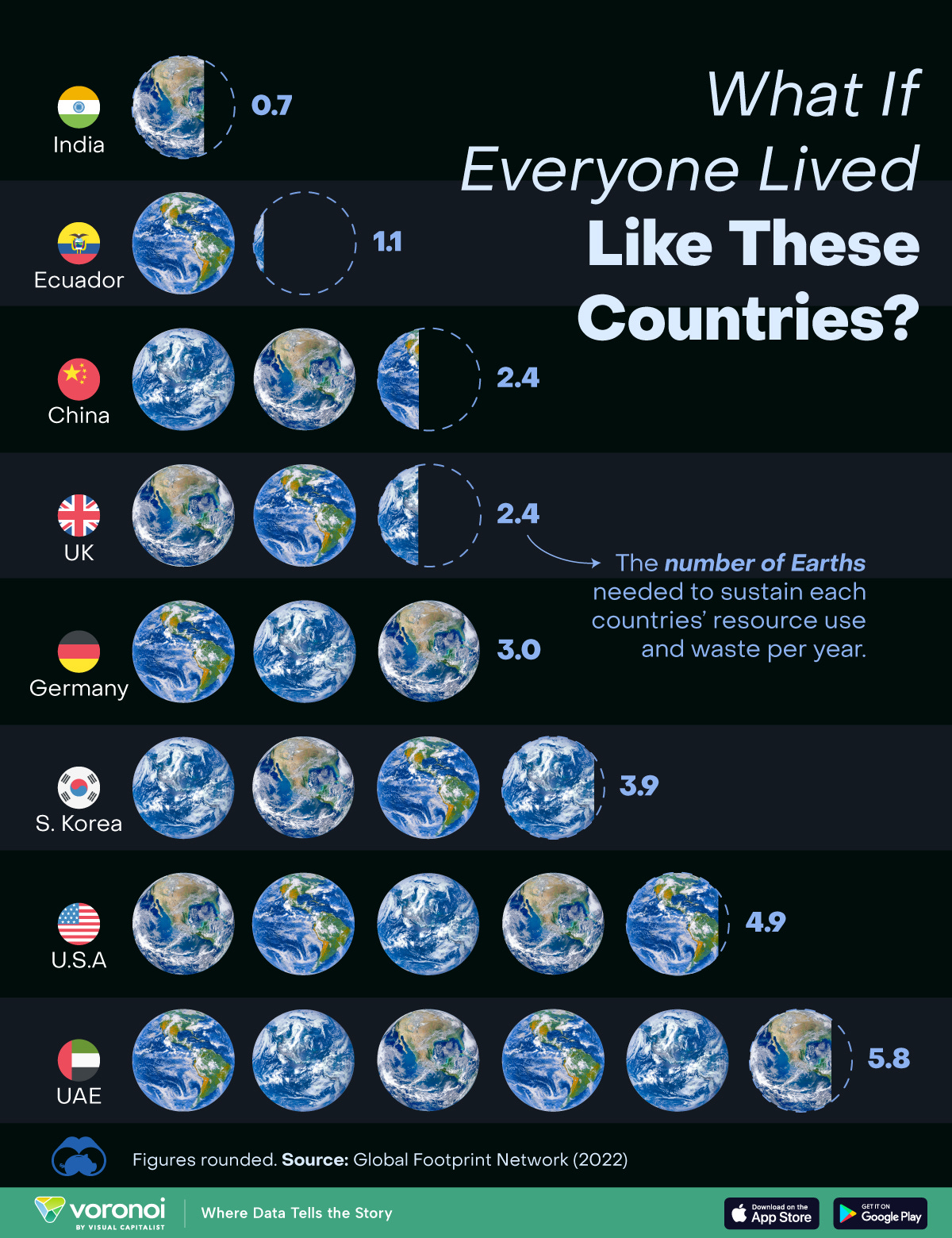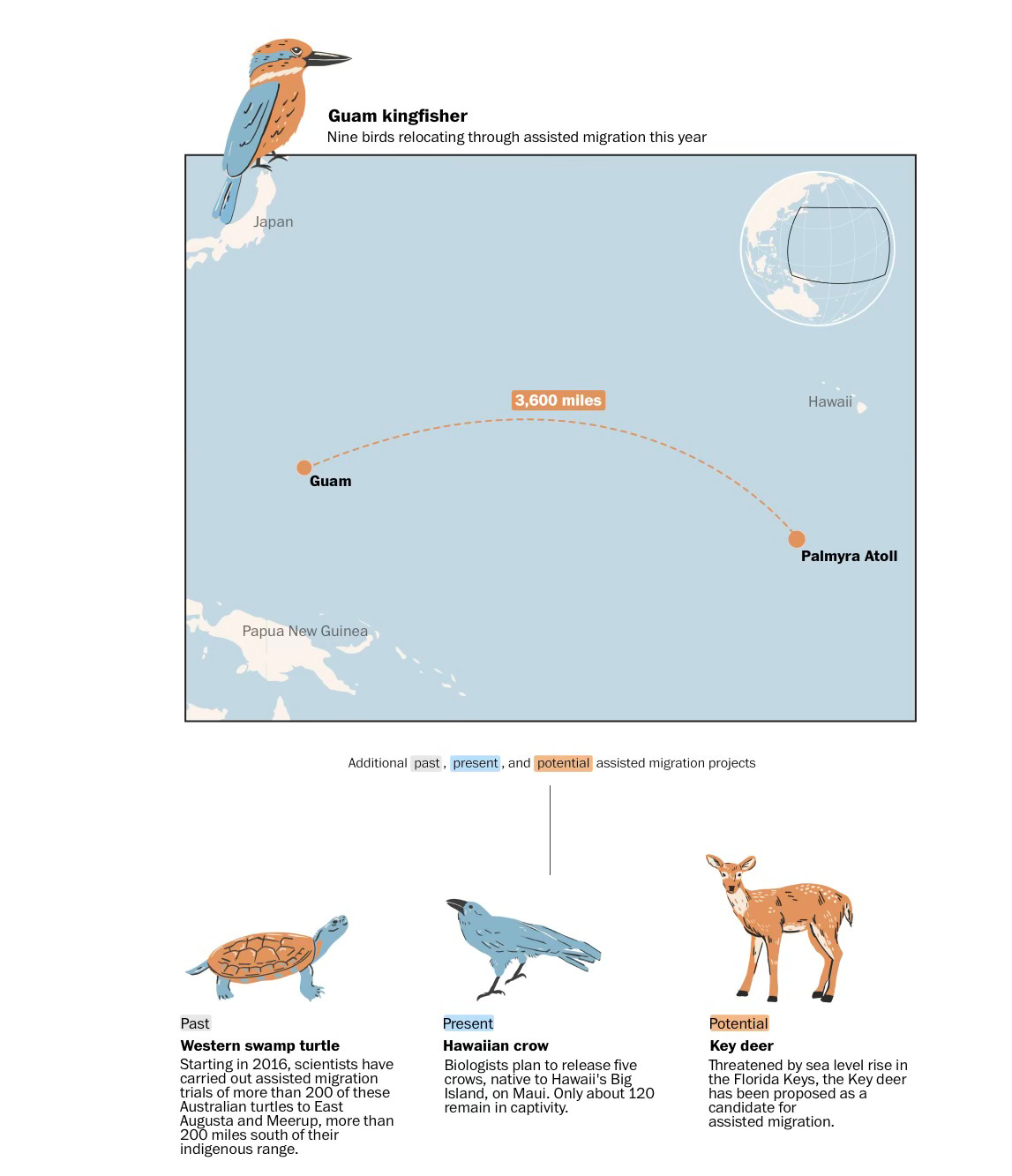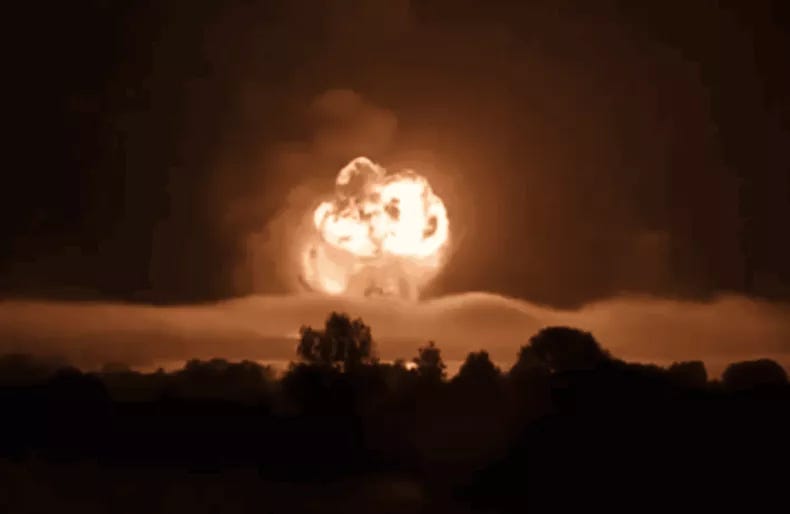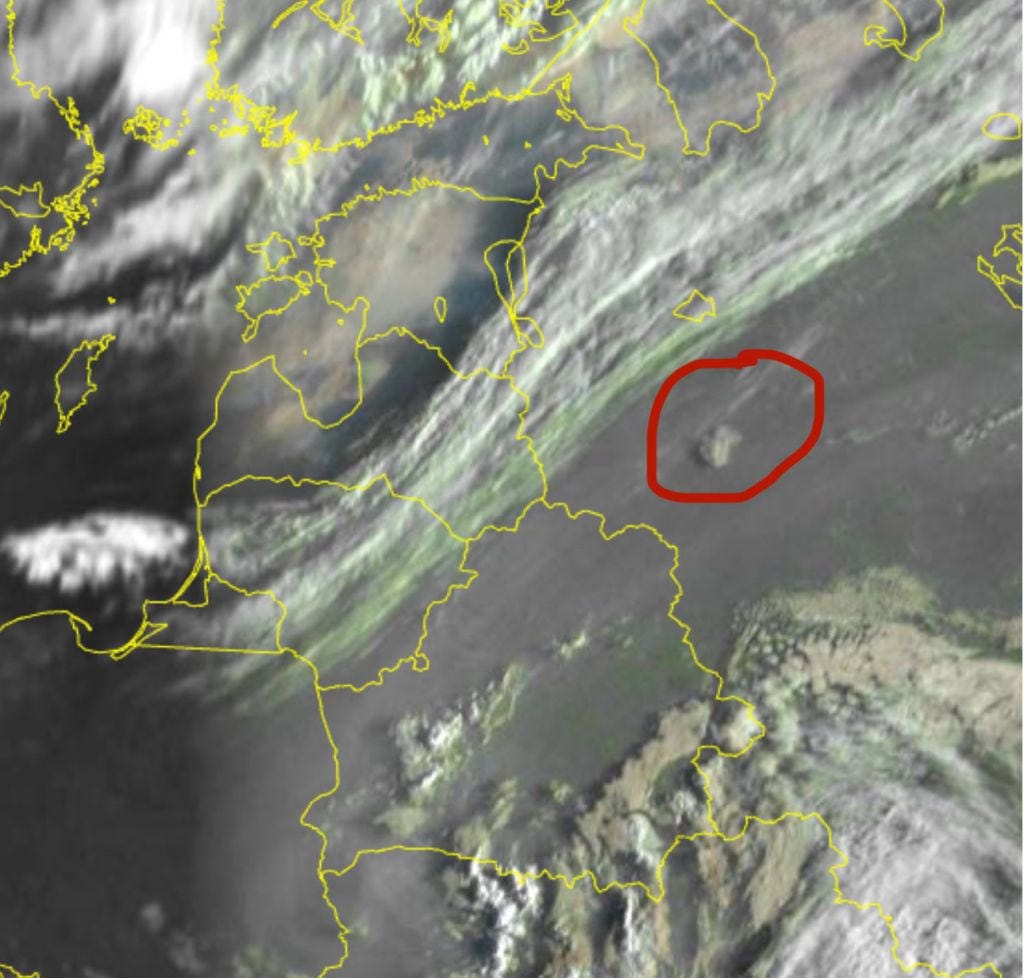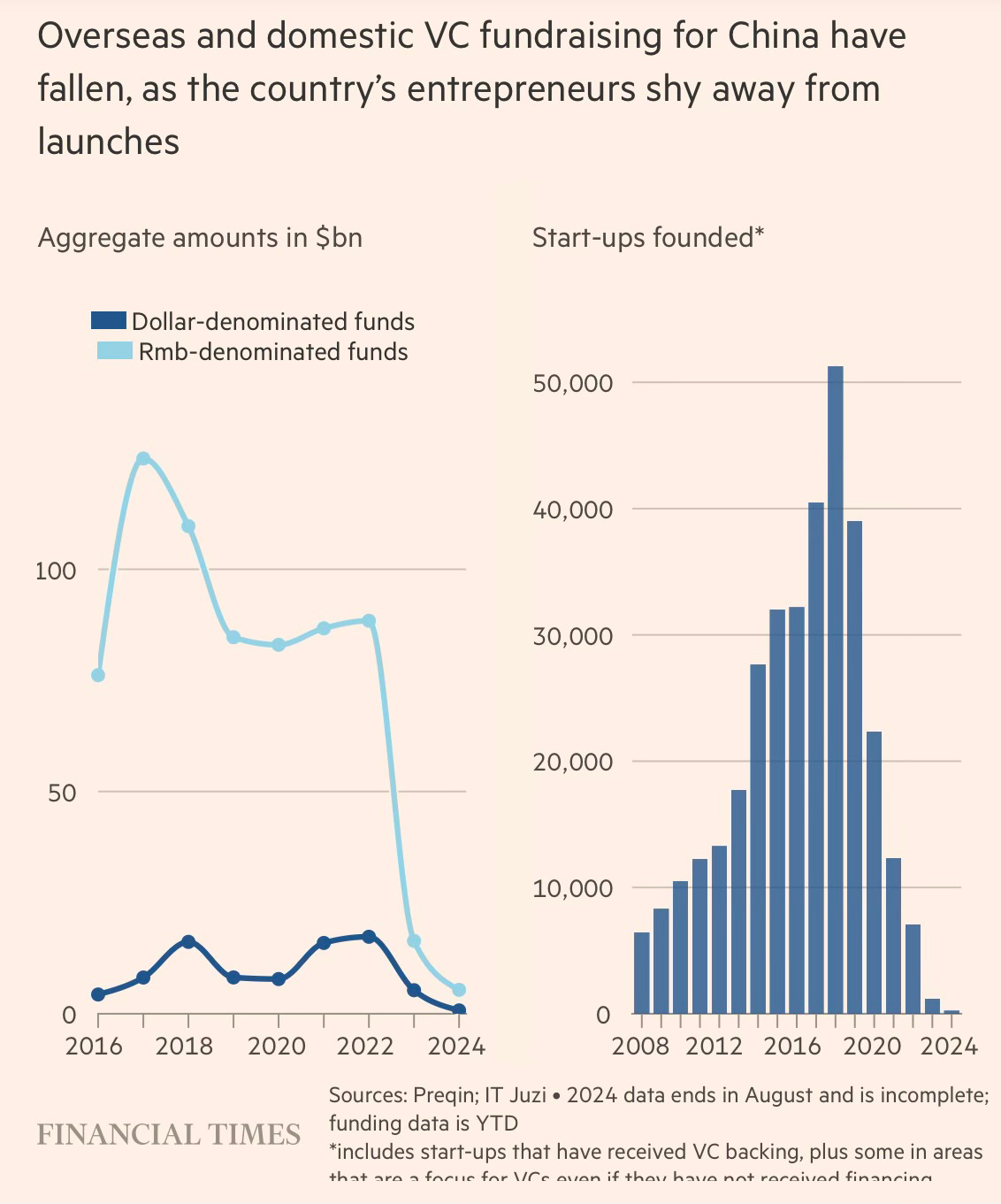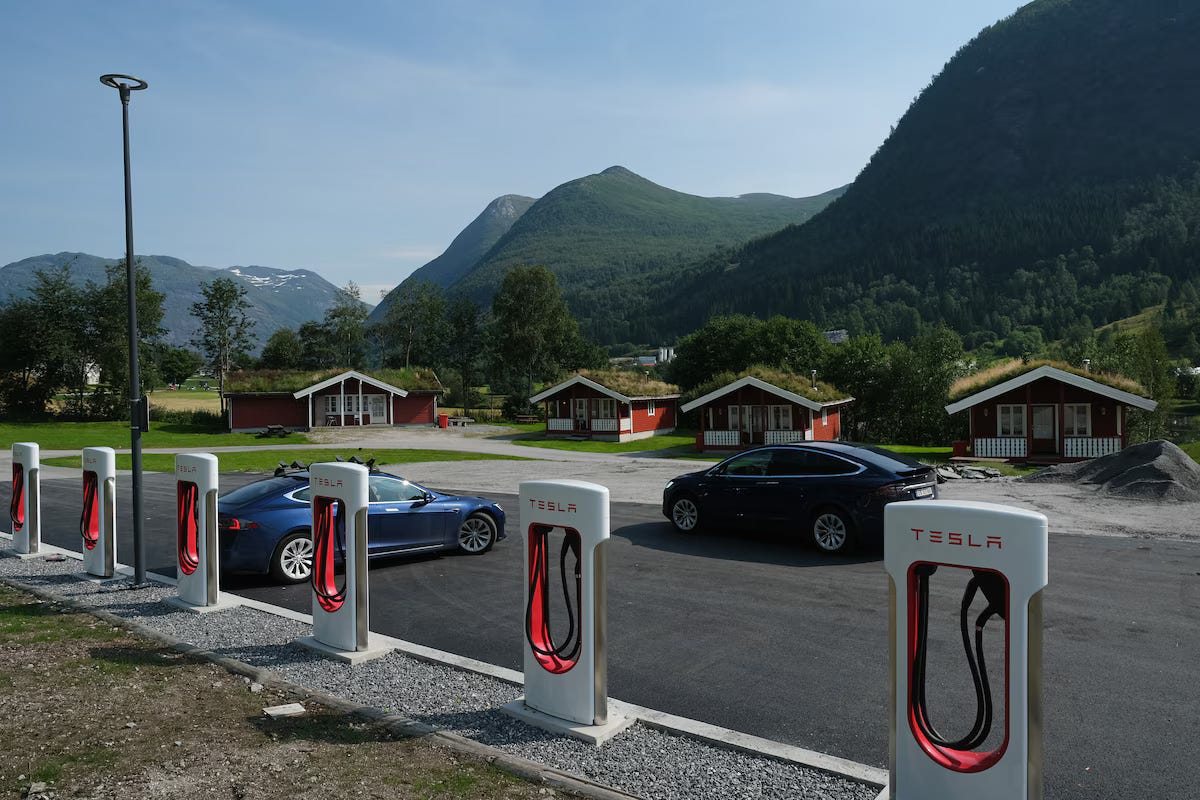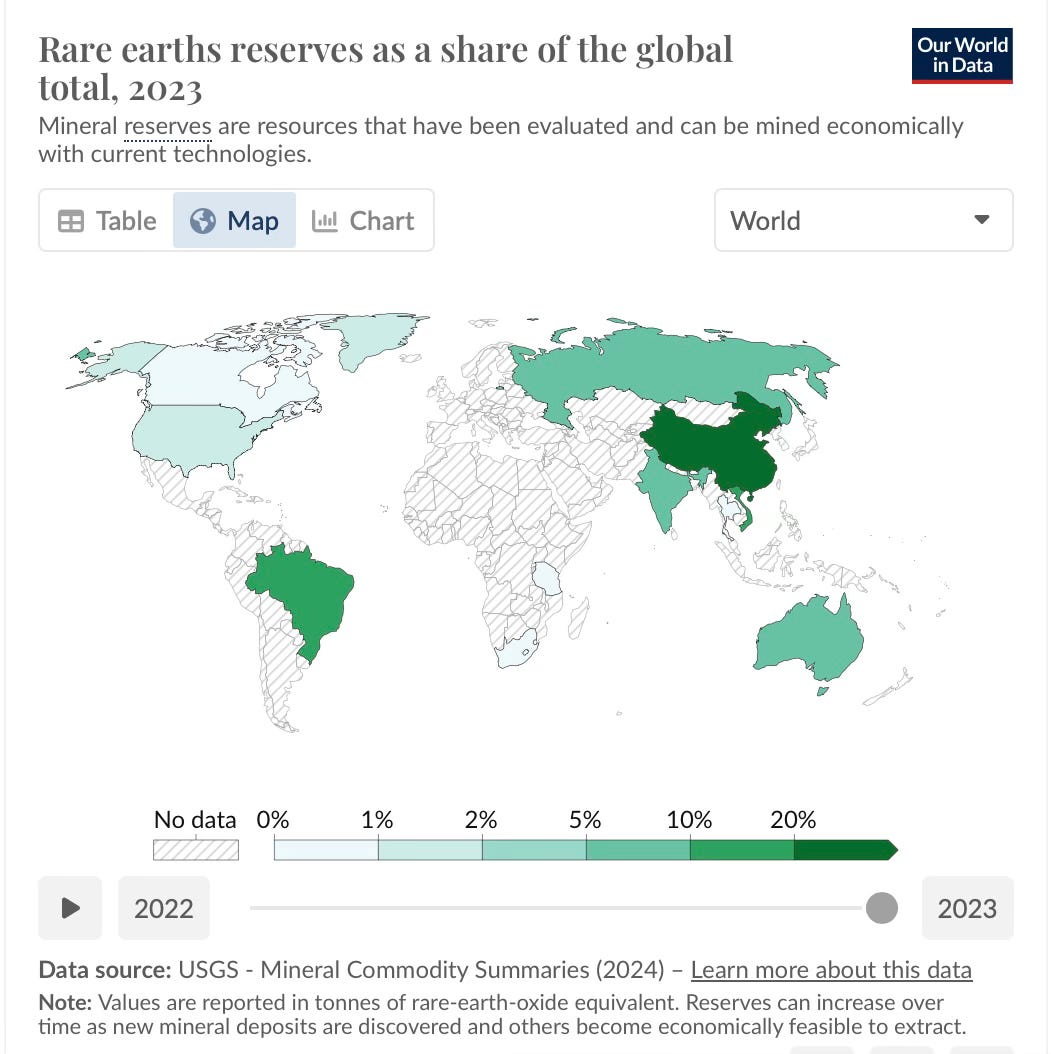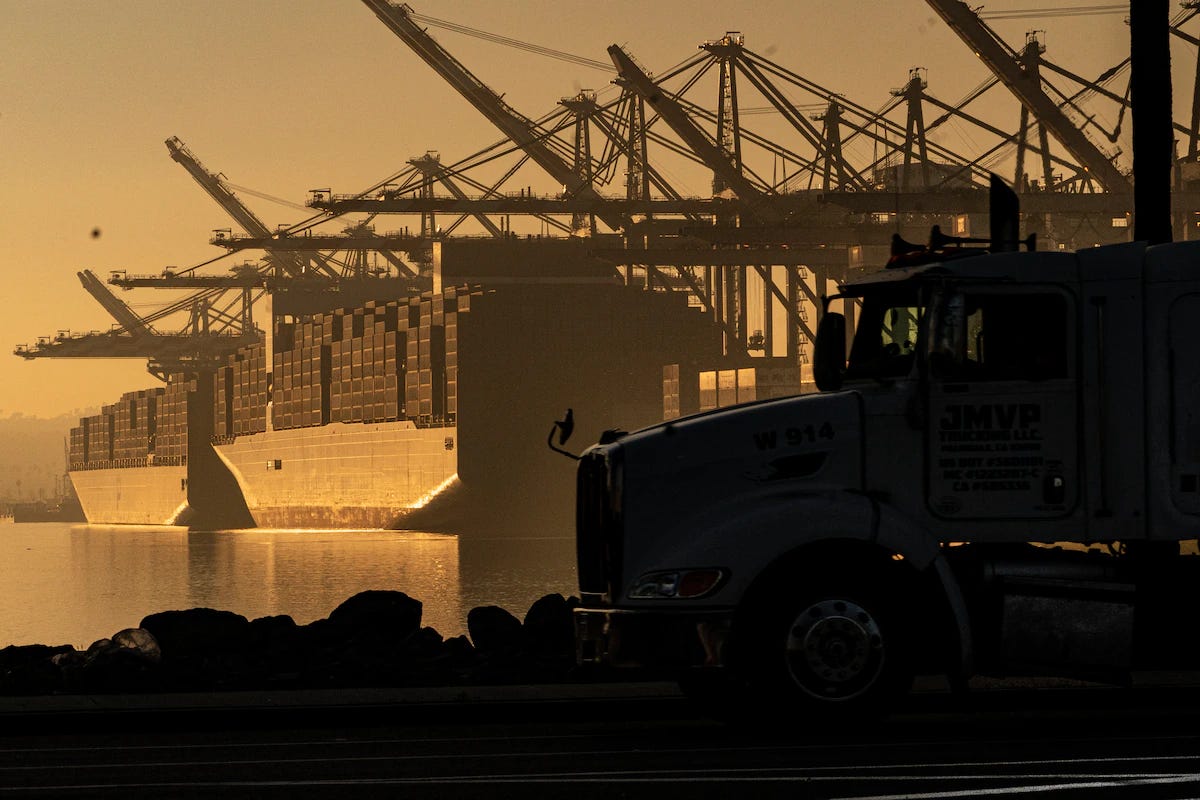1) If I had a nickel for every Earth we’d need to …
VISUAL CAPITALIST: The Number of Earths Needed for Different Countries’ Lifestyles
I love this bread basket/bread truck comparison point. It’s incredibly misleading and yet it makes a great point.
I mean, obviously, we got to this point with one Earth and we’ll only have one Earth come, say, 2050, so what this really measures is how some countries get to pull resources beyond what their presumed population share would entitle them to draw.
It then takes that above-average draw and asks, What would happen if the entire world consumed at that same level?
Short answer: not well … if we all tried to live “rich” and did so without changing our past ways whatsoever.
Got it!
Of course, jumping ahead to that outcome doesn’t really make any sense because it would be the journey there that really mattered in terms of limitations reached and new technologies applied to work around them. Those things tend to go hand in hand throughout human history.
As it is now, every USA or UAE requires a number of poorer countries to balance out their above-average resource draw. Thus, the US can only stay the US — in terms of extant resource utilization — if other countries are prevented from “rising” and thus claiming their share. That is a very mercantilist — or dare I say Trumpian? — way of viewing the world and progress.
Yes, very zero-sum and, on that basis, incredibly STUUUUUPID!
India, right now, with 45% of its labor still in agriculture, claims only .7 of one Earth — if we all lived like present-day India. But India risen will clearly claim more. Same for the Global South. Do we expect such monumental journeys will unfold without massive amounts of innovation to accommodate all that demand? That would be a weird, ahistorical assumption.
Does India’s rise mean the US is resource impoverished in reply? No. It just means we have to do more with less (or find ever more), which is the story of human progress largely told in terms of materials science and engineering.
Does the above analysis reflect a future of additive manufacturing? Doubtful. It’s likely all based on past subtractive manufacturing. What about microgrids that accommodate and exploit the rise of energy prosumers (those who simultaneously produce and consume)? What about all the rationalization of resources and networks made possible by the application of AI that takes the Internet of Things (IoT) and makes them all run collectively so much more efficiently (the AI of Things)?
What analyses like this do for us is to remind us where we’ve come from — not necessarily where we’re headed. If anything, they tell us when we cannot go using old models of resource utilization.
That’s not really something we’ve done as a species as progress has unfolded — by definition.
So, a cool calculation as a motivator but not anything to get all bent out of shape over.
2) Noah’s Ark, my ass!
WAPO: These birds are almost extinct. A radical idea could save them.
It has a nice Twilight Zone quality to it:
As climate change and other threats destroy the habitats of living things, biologists are beginning to think of doing the once unthinkable: finding new homes for species outside their native ranges.
Here in Kansas — in a beige shipping container tucked between a hay barn and a cattle pasture — one of the rarest tropical birds in the world is getting a second chance to soon fly free in the wild. It’s about as far from an island forest as one can get.
For weeks, Erica Royer has been preparing these cinnamon- and cobalt-colored birds for a flight thousands of miles across the Pacific to their new island home.
To get them ready, she’s played tropical island noises — rainfall, seabird squawks, the occasional ATV — from a portable speaker while feeding and cleaning her tiny flock, each a member of a species called the sihek, or Guam kingfisher.
“We want them to get used to the sounds,” said Royer, an aviculturist with the Smithsonian’s National Zoo and Conservation Biology Institute.
This “translocation” essentially replicates the “move” part of the adapt, move, or die choice faced by all species in response to climate velocity — or the movement of specific climactic conditions across the Earth’s surface.
Now, understand, that’s NOT the driving causality here. The specific story here is one of invasive species brought to the island by human activity. And yet, the same logic will be replicated all over the planet due to climate change.
For example, when you’re talking Guam, located at 13 degrees north of the equator (or smack dab in the middle of my Middle Earth), figuring out a place that will replicate that environment for the long haul? That’s tricky. When I went to that website that will tell you where your current city will “move” due to climate change over the next half-century and punched in Guam cities, I got the same answer for each of them:
Future climate for this location is expected to be unlike anything currently found anywhere on Earth, so there are no climate matches for this location.
Basically, does not compute!
So, guess what? Even if it wasn’t for those invasive snakes that threaten this bird species, there’d still be a question as to whether or not Guam would remain hospitable enough to its namesake kingfisher (a calculation not made in this reporting).
Anyway, here we’re talking the opposite calculation: Which place in 60 years will replicate what’s going on in Guam right now (which, presumably, these birds do just fine with)?
Tapping all the AI I can get my hands on at the moment, I come up with the same general advice: namely, move about 2-300 miles northward. That’s the default answer, which tends not to apply to Middle Earth.
Thus, apparently, these scientists have figured the next best thing for these birds, and so they’re attempting this mini-Noah’s Ark approach that moves them to other side of the Pacific to an uninhabited holding of the US known as Palmyra Atoll.
Here’s the thing, the lower the original location is in latitude, the more likely you get one of two truly different outcomes with that U Maryland website that calculates how far your current city will “move” in terms of climate velocity: 1) it will not compute, or 2) it will compute to a similar latitude but unbelievably far away!
That seems to be the case here, despite the UM site’s punting on the question of Guam 2080.
Example: when you punch in Honolulu in that website (the closest US city to Guam), it’ll tell you that the 2080 version of Honolulu is going to look and feel an awful lot like the Dominican Republic does today, or a shift of about 5,500 miles due east.
So, if we were to apply the same logic to Guam, we’d probably get someplace upwards of 5,000 miles east of it, which is kind-of in the same general location as the Palmyra Atoll, meaning, it would seem, that our scientists in this instance are not only working the invasive-species equation (otherwise, why not take them to Hawaii) but likewise the climate change equation.
Interesting …
Larger point being, with climate change, we’re going to see a lot more of these translocating attempts.
Tiny Noah’s Arks heading all over the planet.
Humans plan and God laughs.
3) Our NCOs are better than your flags
WAPO: The U.S. military’s true advantage against any adversary
Universally acknowledged within the national security community but almost completely unknown outside it, the strength of the US Military is not so much our weaponry and tactics but those who wield it — specifically, non-commissioned officers (NCOs) who serve as the key bridge between enlisted personnel below and officers above.
More specifically, our military’s nimbleness and speed are most enabled by the fact that our NCOs can make decisions on the battlefield that, in virtually every other military around the world (but particularly those of authoritarian regimes), would require the coordination and approval from far higher-ups in the ranks. In effect, our NCOs can act and command at the level of other nations’ flag officers (generals, admirals).
Seriously.
That means our average OODA Loop (observe, orient, decide, act) tends to be radically faster in execution, which is a huge advantage in any fight. We just adjust faster by pushing decision-making power down lower in the ranks.
So it’s like this: we have that many more brains processing decisions than the other side, and the bulk of those decisions are made far closer (shorter loops) to the pointy end of the spear within our ranks.
More brains thinking faster beats fewer brains thinking slower. Duh!
We make that system of trust work — and work well — because of the time and money the Defense Department spends on training and educating its NCOs, who today are more and more likely to be armed with a BA or BS to boot (surpassing the old dividing line of HS grad-NCOs and college grad-officers).
The op-ed cited here makes the proximity point nicely:
Leadership that’s local is often just better. And lately, technology has been working to empower the noncommissioned officers even more. The drone and satellite driven conflict in Ukraine has underscored the extent to which sensors will be feeding intelligence directly to small units on the front line, forcing NCOs to think and work even faster.
That’s a key point: our approach swims in the same direction as technology’s tide — not against it. Technology is taking everything local, resulting in the reality that …
Supply is global, demand is local.
Say it with me …
The piece ends with this broad-framing:
Fostering leadership in a massive organization such as the Army or the Navy holds useful lessons for civilian leaders: empower your workforce, encourage (and subsidize, when possible) education to help the team keep pace with innovation and technology — and keep pushing authority down the chain of command.
It always bears repeating.
4) The Military Singularly moving left of boom (and getting an even bigger boom)
NEWSWEEK: Satellite Photos Reveal Damage from Attack on Russia's Biggest Ammo Storage
Okay, that’s obviously not a sat photo, but you have to admit it’s pretty impressive for a non-nuclear blast. If you want that level of destruction, you need to hit an ammunition storage facility, which is what Ukraine just did — way over the border in Russia and using only drones.
Drones killing troops in their beds, killing them when they’re mustering, killing them in their covered trench positions … it just seems unfair, does it not?
This I like better: blow up their ammo dumps way behind the front lines. Make a boom so big the resulting cloud of dust and debris can be viewed from space.
Now we’re talking:
The Institute for the Study of War (ISW) said Wednesday that continued Ukrainian strikes on logistics sites within Russia "will generate wider operational pressures on the Russian military beyond the individual destruction of ammunition stockpiles and logistics facilities."
When your stated goal is to turn a battlefield (I’m thinking … Taiwan) into a “drone hellscape,”that tells you we’re nearing the point of pointlessness on conventional warfare. Drones killing drones proves … it has to prove something.
But managing to go that much farther upstream (left of boom, as they say), that drives home the point(lessness) all the more.
A Taste of Armageddon
Episode aired Feb 23, 1967
Kirk and Spock must save their ship's crew when they are all declared killed in action in a bizarre computer simulated war where the actual deaths must nevertheless occur.
I just rewatched the Star Trek (original series) episode called “A Taste of Armageddon.” That antiseptic logic (“Let’s skip all the kinetics and just send AI-identified causalities to the disintegration chamber!”) was borrowed from nuclear war. Soon enough, it will seem just as satirically applicable to conventional warfare.
You know, like killing the other guy’s troops by blowing up their personal electronic devices — bringing that “disintegration chamber” to you!
Ohh! What a world! What a world!
I gotta say: I like where this is going.
LAST MINUTE ADDITION: Ukraine Hits 2 More Russian Munition Depots, Aiming to Disrupt War Effort
5) Not to be outdroned
EURASIAN TIMES: 1st Time In Ukraine War — Russia Unleashes ‘Mothership UAV’ To Launch Kamikaze FVP Drones On Ukrainian Positions
Apparently, Ukraine had already debuted its version of a drone mothership months ago.
Worry not. The Pentagon got the memo!
Mother ships for drones will be ‘extremely important’ for the Navy’s future fleet, Secretary Del Toro says
The fact that the US Navy is looking to repurpose the Littoral Combat Ship (LCS), Art Cebrowski’s brainchild from my Office of Force Transformation days … just puts a bow on it.
Even cooler: even the mothership is being considered naturally “attritable” (“Attritable UxS Mother Ship”). That was always the bugaboo about the LCS: the notion that it was disposable like a fighter jet (get in trouble, pull the cord!). That concept went over like a lead balloon with Congress.
Still, recall my mantra from my OFT days: the many, the cheap, the disposable, the unmanned.
I will keep using disposable until the spell checker lays off attributable … I mean, attritable.
The preferred Pentagon (Replicator program) version? ‘Small, Smart, Cheap and Many’ Autonomous Systems.
That works too.
This is the timeframe I operate on: say it now, see it in twenty years, forget about getting credit.
You find your satisfaction elsewhere.
Anticipation is everything everywhere all at once.
6) Xi and the golden goose
Xi’s disastrous legacy grows …
“China used to be the best VC destination in the world after the US,” says one Beijing-based executive, referring to the business of private investment in high-risk start-up companies. Founders and investors harbour few hopes of a return to the glory years before the Covid-19 pandemic, when the likes of Alibaba and Tencent took advantage of rapid economic growth and the rise of the mobile internet to become globally significant technology companies. “The whole industry has just died before our eyes,” the executive continues. “The entrepreneurial spirit is dead. It is very sad to see.”
The VC industry made China:
Keyu Jin, associate professor at the London School of Economics, says the industry “has been critical to spur China’s entrepreneurial dynamism”.
“The outflow of global investment and the massive drop in the valuation of Chinese companies will impinge on the nation’s innovation drive,” she warns.
And Xi is to blame:
… the direct result of political decisions taken by President Xi Jinping that have dramatically changed the environment for private business in China — including a crackdown on technology companies regarded as monopolistic or not attuned to Communist party values, and an anti-corruption crusade that continues to ripple through the business community. Desmond Shum, author of Red Roulette and a former real estate mogul, says the party “has throttled the private sector”.
“Successful entrepreneurs . . . can expect to be closely monitored, unable to transfer money offshore and their transactions and public statements scrutinised,” he adds. “Their money is the country’s money.”
Xi’s rise to undisputed one-man rule is not a threat to the US. It’s a threat to China.
7) It can be done (first of two)
REUTERS: Ozone layer on road to recovery despite volcano eruption, UN weather body says
For those of us old enough to remember the perceived threat/doom!
The world's ozone layer is on "the road to long-term recovery" despite a destructive volcanic eruption in the South Pacific, the World Meteorological Organization said on Tuesday, after efforts to phase out ozone-depleting chemicals.
On current trends, the ozone layer is on track to recover to 1980 levels by around 2066 over the Antarctic, 2045 over the Arctic and 2040 for the rest of the world, the United Nations agency said.
It gives you a sense of course-correction with regard to something huge like our planet’s climate: it takes close to a century.
What we do now on global warming is about fixing the 22nd century — not this one. This one is mostly going to be about adaptation — a realization that drove me to write America’s New Map: When you see a problem, rush toward it and embrace it for all the opportunities it presents.
8) It can be done (second of two)
WAPO: This country is now the world’s first to have more EVs than gas-powered cars
Hats off to Norway — my preferred definition of the coolest country out there and the one place I would consider living outside of the US.
Norway is the first country in the world with more electric vehicles than gas-powered cars on the road, according to vehicle registration data the Norwegian road federation, known as OFV, released Tuesday.
Of the 2.8 million passenger cars registered in the country, 26.3 percent are fully electric, just edging out the share of gas vehicles. Diesel remains the most common vehicle type, making up more than a third of Norwegian vehicle registrations.
Okay, so not as cool as implied because diesels still rule (for now), but you get the idea.
It can be done!
9) Silver tsunami meet silver economy
NYT: China’s ‘Silver Economy’ Is Thriving as Birthrate Plunges
A killer lede segment:
For more than a decade, Li Dongmei operated a series of kindergartens and schools for young children, withstanding the realities of China’s declining birthrate. She finally faced the music in 2020.
The shrinking number of children meant ever smaller enrollments of babies and toddlers at her schools. The social and economic ruptures of the Covid-19 pandemic were the breaking point, and she shifted her focus to a different and more abundant set of pupils: the elderly.
At her education center in Jinan, a city in eastern China, she now offers singing, dancing, music and art classes for seniors. She organizes activities and educational trips for her students. Unlike schoolchildren who have summer and winter holidays, Ms. Li said, older people take classes all year round. And the classes are full.
“The biggest economy is the silver economy,” said Ms. Li, 36. “It is bigger than the children’s market.”
That’s how fast China got old. It’s also why China went crazy cashing in its demographic dividend. The demographic transition is a one-way street.
Demand shifts and the market responds:
Dairy companies that produced formula for China’s infants are now developing powdered milks for seniors. Proprietors of preschools and kindergartens are closing those facilities to start senior care centers. A technology firm that made devices for parents to track their young children is now designing products allowing grown children to keep tabs on their aging mothers and fathers.
Xi Jinping mistakenly thinks he can force China’s continued growth by refusing to embrace consumerism and doubling-down on exports (now both hi- and low-end). None of that matters to an aging society rearranging the economy.
The picture says it all:

The diapers just get bigger, that’s all.
And yes, I’m aware my days are numbered — just like all of you.
10) There is who has the most, who mines the most, and who refines the most
OUR WORLD IN DATA: Which countries have the critical minerals needed for the energy transition?
I am a huge fan of Our World in Data and used them a ton in America’s New Map.
What’s so interesting about this tour d’horizon of strategic materials is understanding the difference of where stuff is, where it is being mined, and who is doing the advanced processing. These are very different things.
The article’s upfront explainer is worth noting:
A quick note on terminology
The focus of this article will be on mineral production and reserves.
We will explore the data for two forms of production.
The first is mine production. As the name suggests, this is what’s directly mined out of the ground. This is often impure and mixed with other minerals or rocks. It usually needs to be refined to get it into a usable or final form.
That’s the second form of production. Refined production is the conversion and separation of the raw mineral into a pure or final form used in manufacturing. As we’ll see, the countries that do the mining are often different from those doing the refining.
The second key metric to focus on is reserves. Reserves tell us how much known and assessed mineral deposits can be mined economically with current technologies and market conditions. These are not to be confused with “resources”, which describes the total amount of available minerals. Reserves are resources that are economically viable today. We have a short explainer on this.
Both metrics — reserves and resources — can change over time as we find new deposits and known ones become more economical.
So, just because you have a reserve doesn’t mean you’ll mine it. It may be too hard, or just too costly, or just too environmentally damaging. Also, just because you mine it doesn’t give you the power, because a lot of that comes with the processing.
Finally, and although it is not spelled out here explicitly, the larger truth is that, when something becomes super-valuable, humans tend to go nuts searching for it and tend to find it (e.g., our recent HUGE lithium find in Nevada). And, if that trajectory ever dead-ends, then we develop a new technology that makes do with an alternative material.
That is human ingenuity and human progress and most of what we call history. Like the old quip says, the Stone Age didn’t end because we ran out of stones.
This throughline is why predictions of peak-anything almost always turn out to be bogus, because peak-demand tends to precede peak-supply.
Why? Because we’re humans and we’re smart — get used to it!
11) Is it time to re-globalize already?
WAPO: After Trump and Biden, a path toward re-globalization
Just a very cool op-ed by an infrequent WAPO columnist, Eduardo Porter, who is always sharp. In it, he relays this powerful bit of logic from a global economics expert whom I deeply respect:
Adam Posen, presidentof the Peterson Institute for International Economics, suggested the “middle countries” of the world — countries such as Indonesia, Singapore, Kenya and even member states of the European Union — whose economic success relies on an open world economy send a message to Washington: “lead, follow or get out of the way.” If the United States (or, indeed, China) refuses to engage, other countries of the world should work to carve out their own deals to govern trade and investments. The United States should be invited to join, but it should not be allowed to veto the process.
This is where our abandonment of our ethical market-making role (let’s say, 1945-2008) has left us: we’re viewed as increasingly selfish and old.
From America’s New Map:
America cannot hope to globally champion our middle-class-centric approach to progressive reform if we ourselves are lost to generational conflict between old and young—particularly over our response (or lack thereof) to climate change. The danger we face, per Jackson and Howe, is that Americans are “no longer regarded as progressive advocates for the future of all peoples, but rather as mere elder defenders of their own privileged hegemony.”
That is EXACTLY what we are selling the world with our Boomer/GenX leadership cohort, with Trump just the cherry on that sundae.
Back to the op-ed:
The Biden administration has done nothing to restore the WTO’s dispute settlement mechanism, the essential institution to solve conflicts over trade. The Trump administration effectively blew it up by blocking appointments to its appellate body and thus denying it a quorum — essentially allowing powers such as the United States to simply ignore adverse rulings.
This is America disavowing its own creations, citing “national security” as the excuse (often the worse cop-out).
It’s a losing long-term strategy: defensive, rear-guard, reactionary … the opposite of leadership toward a better tomorrow.
Porter ends the piece thusly:
The key question is whether, given these constraints, the rest of the world can continue to build an interconnected global economy in the absence of its main architect. The other question is about what the United States is willing to lose by allowing the rest of the world to go forward in its absence to protect an amorphous, indefinite national security yard.
We have this HUGE military industrial complex and global footprint reflecting our firm dedication to preventing WWII by the wanton abrogation of state sovereignty. This is why we view Ukraine and Taiwan as the ultimate superpower contests for world domination (because it’s always a slippery slope).
The problem is: that’s not really the problem going forward — nor the challenge, so we are overwhelmingly built for the past — one gigantic sunk cost we cannot shake off EVEN as warfare is being radically redefined in Ukraine and globalization, per this op-ed, is moving on without us.
Here’s where those two giant trends meet: at the start of the century, the digital portion of global trade was negligible. Now, it’s more than half of its value.
Tanks and fighter jets and carriers are not going to cut it. We’re moving into new realms but applying 20th century strategic concepts such as containment, Cold War, and the always looming WWIII!
It is a dialogue of the strategic deaf.
12) Displacement stories
GRIST: Climate migration doesn’t look like you think it does
Interesting coverage of an interesting project:
A storytelling fellowship for resettled youth empowers them to tell their own stories of displacement, countering media stereotypes of refugees.
It goes by the name of Narratio. Very Throughline-ish in vibe.
By working with displaced young people, [Narratio leaders] have acquired a more expansive view of climate displacement, they said. In some cases, fellows’ migration pathways illustrate how conflicts over land, food, and other natural resources are inextricable from environmental changes. In others, they demonstrate climate change’s role as a threat multiplier.
Mohamed’s family, for instance, initially left Somalia due to the ongoing civil war. But environmental factors drove her family’s eventual move to the United States. During their time in Ethiopia, volatile weather made life in the refugee camp increasingly untenable. Severe droughts compromised their food and water sources. These dry periods were interrupted by tornadoes and flooding, which destroyed improvised shelters and even drowned young children. It’s an example of how climate volatility can drive further involuntary movement — making refugees’ lives even more tenuous, and dissuading displaced people from settling in neighboring countries that are vulnerable to climate impacts.
And, more and more, environmental hazards are becoming the primary cause of displacement.
This is a big problem with our estimates of the future and who will likely be displaced: narrow stovepiped definitions that don’t take into account the convergence of negative developments — their synergy. If our standard is, climate change and climate change alone must account for all of your reasoning in migrating north, then we will vastly underestimate the likely billion souls that will be put on the move around mid-century.
We can get ready for it or we can hide ourselves behind ever-higher walls.





